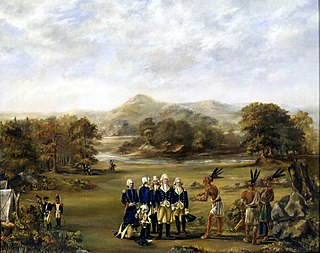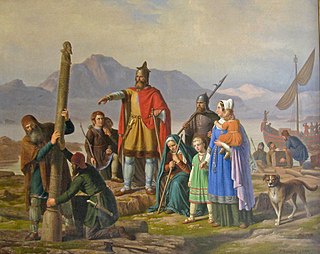
The Northwest Territory in the United States was formed after the American Revolutionary War, and was known formally as the Territory Northwest of the River Ohio. It was the initial post-colonial Territory of the United States and encompassed most of pre-war British colonial territory west of the Appalachian mountains north of the Ohio River. It included all the land west of Pennsylvania, northwest of the Ohio River and east of the Mississippi River below the Great Lakes. It spanned all or large parts of six eventual U.S. States. It was created as a Territory by the Northwest Ordinance July 13, 1787, reduced to Ohio, eastern Michigan and a sliver of southeastern Indiana with the formation of Indiana Territory July 4, 1800, and ceased to exist March 1, 1803, when the southeastern portion of the territory was admitted to the Union as the state of Ohio, and the remainder attached to Indiana Territory.

The Northwest Indian War (1785–1795), also known as the Ohio War, Little Turtle's War, and by other names, was a war between the United States and a confederation of numerous Native American tribes, with support from the British, for control of the Northwest Territory. It followed centuries of conflict over this territory, first among Native American tribes, and then with the added shifting alliances among the tribes and the European powers of France and Great Britain, and their colonials.

The Battle of Chillicothe was part of the western theater of the American Revolutionary War.

John Ketcham was an American self-taught surveyor, building contractor, and judge.

The history of Indianapolis spans three centuries. Founded in 1820, the area where the city now stands was originally home to the Lenape. In 1821 a small settlement on the west fork of the White River at the mouth of Fall Creek became the county seat of Marion County in 1821, and the state capitol of Indiana, effective January 1, 1825. Initially the availability of federal lands for purchase in central Indiana made it attractive to the new settlement; the first European Americans to permanently settle in the area arrived around 1819 or early 1820. In its early years most of the new arrivals to Indianapolis were Europeans and Americans with European ancestry, but later the city attracted other ethnic groups. The city's growth was encouraged by its geographic location, 2 miles (3.2 km) northwest of the state's geographic center. In addition to its designation as a seat of government, Indianapolis's flat, fertile soil, and central location within Indiana and Midwest, helped it become an early agricultural center. Its proximity to the White River, which provided power for the town's early mills in the 1820s and 1830s, and the arrival of the railroads, beginning in 1847, established Indianapolis as a manufacturing hub and a transportation center for freight and passenger service. An expanding network of roads, beginning with the early National Road and the Michigan Road, among other routes, connected Indianapolis to other major cities.
Logan's Raid was a military expedition in October, 1786 by Kentucky militia under General Benjamin Logan against several Shawnee towns along the Little Miami and Mad Rivers in Ohio Country. The villages were occupied primarily by noncombatants, since most warriors had left to defend the villages of Chief Little Turtle from a separate force moving up the Wabash River under the command of General George Rogers Clark. Logan seized and burned thirteen villages destroying the food supplies and killing or capturing many, including the aged Chief Moluntha who was soon murdered by one of Logan's men, reportedly in retaliation for the Battle of Blue Licks in the American Revolutionary War.
William Graham was a Speaker of the Indiana House of Representatives and Congressman from Indiana. Born at sea, Graham settled with his parents in Harrodsburg, Kentucky. He attended the public schools. He moved to Vallonia, Indiana, in 1811 and engaged in agricultural pursuits. He was elected to serve as member of the Indiana Territory's house of representatives in 1812 and was elected as delegate from Washington County to the State constitutional convention in 1816. He was elected six times as a member of the Indiana House of Representatives from 1816 until 1821, and was speaker of the house during the 1820-1821 session. He was elected and served four terms in the Indiana Senate from 1821 until 1833, representing Jackson County.

Vallonia is an unincorporated community and census-designated place (CDP) in Driftwood and Brownstown townships, Jackson County, Indiana, United States. It was an 18th-century French settlement and 19th-century American frontier fortification known as Fort Vallonia. As of the 2010 census, Vallonia had a population of 336.
During the American Civil War, Indianapolis, the state capital of Indiana, was a major base of supplies for the Union. Governor Oliver P. Morton, a major supporter of President Abraham Lincoln, quickly made Indianapolis a gathering place to organize and train troops for the Union army. The city became a major railroad hub for troop transport to Confederate lands, and therefore had military importance. Twenty-four military camps were established in the vicinity of Indianapolis. Camp Morton, the initial mustering ground to organize and train the state's Union volunteers in 1861, was designated as a major prisoner-of-war camp for captured Confederate soldiers in 1862. In addition to military camps, a state-owned arsenal was established in the city in 1861, and a federal arsenal in 1862. A Soldiers' Home and a Ladies' Home were established in Indianapolis to house and feed Union soldiers and their families as they passed through the city. Indianapolis residents also supported the Union cause by providing soldiers with food, clothing, equipment, and supplies, despite rising prices and wartime hardships, such as food and clothing shortages. Local doctors aided the sick, some area women provided nursing care, and Indianapolis City Hospital tended to wounded soldiers. Indianapolis sent an estimated 4,000 men into military service; an estimated 700 died during the war. Indianapolis's Crown Hill National Cemetery was established as one of two national military cemeteries established in Indiana in 1866.

Indian removals in Indiana followed a series of the land cession treaties made between 1795 and 1846 that led to the removal of most of the native tribes from Indiana. Some of the removals occurred prior to 1830, but most took place between 1830 and 1846. The Lenape (Delaware), Piankashaw, Kickapoo, Wea, and Shawnee were removed in the 1820s and 1830s, but the Potawatomi and Miami removals in the 1830s and 1840s were more gradual and incomplete, and not all of Indiana’s Native Americans voluntarily left the state. The most well-known resistance effort in Indiana was the forced removal of Chief Menominee and his Yellow River band of Potawatomi in what became known as the Potawatomi Trail of Death in 1838, in which 859 Potawatomi were removed to Kansas and at least forty died on the journey west. The Miami were the last to be removed from Indiana, but tribal leaders delayed the process until 1846. Many of the Miami were permitted to remain on land allotments guaranteed to them under the Treaty of St. Mary's (1818) and subsequent treaties.

The Indiana Rangers, also known as the Indiana Territorial Mounted Rangers, were a mounted militia formed in 1807 and operated in the early part of the 19th century to defend settlers in Indiana Territory from attacks by Native Americans. The rangers were present at the Battle of Tippecanoe, and served as auxiliaries to the army during the War of 1812. At the peak of their activities they numbered over 400 men.

The Battle of Tipton's Island was an engagement between a Shawnee war party and Indiana militia under command of John Tipton in April 1813 on the White River near Seymour, Indiana.

The Michigan Road was one of the earliest roads in Indiana. Roads in early Indiana were often roads in name only. In actuality they were sometimes little more than crude paths following old animal and Native American trails and filled with sinkholes, stumps, and deep, entrapping ruts. Hoosier leaders, however, recognized the importance of roads to the growth and economic health of the state, and the needed improvements. They encouraged construction of roads which would do for Indiana what the National Road was doing for the whole country.
Ketcham's fort was a 19th-century fort northeast of Fort Vallonia in Jackson County, Indiana.

Charles E. Cox was an American lawyer and judge who became the 55th justice of the Indiana Supreme Court, serving from 1911 to 1917. Elected as a Democrat in the Fall of 1910, he was Chief Justice by the end of his six-year term. The "Marshall Constitution" case and the "Technical Institute" case were among the important decisions made by the court during his tenure. As a judge in the Indiana Supreme Court and in lower courts, he never had a decision reversed.

The Indiana Magazine of History is a peer-reviewed academic journal published quarterly by the Indiana University Bloomington Department of History. Established primarily as a venue for historical documents of interest, particularly on Indiana's territorial and early-statehood periods, the journal today publishes a range of scholarly articles, reviews, roundtables, and interviews covering the history and changing culture of Indiana and the Midwest from early European and Native American encounters to the present.

Delia Ann Webster was an American teacher, author, businesswoman and abolitionist in Kentucky who, with Calvin Fairbank, aided many slaves, including Lewis Hayden, his wife Harriet, and their son Joseph to escape to Ohio. She was convicted and sentenced to two years in prison for aiding the Haydens' escape, but pardoned after two months.
Fredonia is an unincorporated community in Crawford County, Indiana, in the United States.
Magnolia is an unincorporated community in Crawford County, Indiana, in the United States.
Addison Clay Harris was a lawyer and civic leader in Indianapolis, Indiana, who served as a Republican member of the Indiana Senate and a U.S. Envoy Extraordinary and Minister Plenipotentiary (ambassador) to Austria-Hungary. The Wayne County, Indiana, native graduated from Northwestern Christian University in 1862 and was admitted to the bar in 1865, the same year he established a law partnership with John T. Dye in Indianapolis. Harris was a founding member (1878) and president of the Indianapolis Bar Association; a founder and president of the Indiana Law School, which was a forerunner to the Indiana University Robert H. McKinney School of Law in Indianapolis; a presidential elector in 1896; president of the Indiana State Bar Association (1904); a member (1905–1916) and president of Purdue University's board of trustees; and a member of the Indiana Historical Society and the Columbia Club.


















